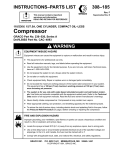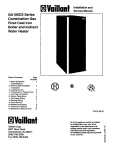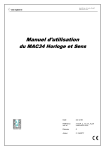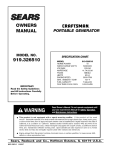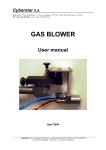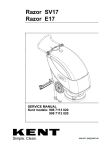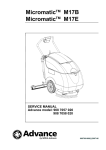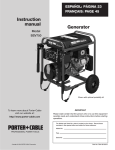Download DeVillbiss Air Power Company MGP-4600 User's Manual
Transcript
OWNERS MANUAL FOR DeVILBISS GENERATOR Model No. GBV4600 SPECIFICATION CHART MODEL HORSE POWER RATED/SURGE WATTS VOLTAGE AMPERAGE PHASE HERTZ ENGINE SPEED MAX. AMBIENT TEMP. FUEL CAPACITY RUN TIME @ 50%/100% GBV4600 9 4600/5750 120/240 38.3A/19.2A SINGLE 60 Hz 3600 RPM 104° F 6 GALLON 13.3/6.5 HR • This product is not equipped with a spark arresting muffler. If the product will be used around flammable materials, or on land covered with materials such as agricultural crops, forest, brush, grass, or other similar items, then an approved spark arrester must be installed and is legally required in the state of California. It is a violation of California statutes section 130050 and/or sections 4442 and 4443 of the California Public Resources Code, unless the engine is equipped with a spark arrestor, as defined in section 4442, and maintained in effective working order. Spark arresters are also required on some U. S. Forest service land and may also be legally required under other statutes and ordinances. • Engine exhaust from this product contains chemicals known, in certain quantities, to cause cancer, birth defects or other reproductive harm. MGP-4600 6/13/95 DeVilbiss Air Power Company • 213 Industrial Drive • Jackson, TN 38301-9615 TABLE OF CONTENTS PAGE WARRANTY STATEMENT ...................................................... 3 SAFETY GUIDELINES AND INSTRUCTIONS ......................... 4-8 WATTAGE CALCULATING INSTRUCTIONS ........................... 9-10 GENERAL PARTS IDENTIFICATION ...................................... 11 GROUNDING INSTRUCTIONS/EXTENSION CORDS ............. 12 INSTALLATION OF A GENERATOR ....................................... 12 OPERATING INSTRUCTIONS ................................................. 13 MAINTENANCE SCHEDULE ................................................. 13 MAINTENANCE PARTS LIST ................................................. 14 TROUBLE SHOOTING GUIDE ................................................ 14 INSTALLATION OF BATTERY ................................................. 15 In the unlikely event you should have a problem with this product or if you are missing any parts, it is not necessary to return it to the store where you purchased it. Simply call our toll-free number and talk with our Service Representative. OUR OFFICE HOURS ARE FROM 8:00 a.m. to 4:30 p.m. (CST) MONDAY THROUGH FRIDAY CALL TOLL-FREE 1-800-888-2468, EXT. 2 2 LIMITED WARRANTY ONE YEAR FROM DATE OF PURCHASE All merchandise manufactured by DeVilbiss Air Power Company is warranted to be free of defects in workmanship and material which occur during the first year from the date of purchase by the original purchaser (initial user). Products covered under this warranty include: air compressors, *air tools, accessories, service parts, pressure washers, and generators used in consumer applications (i.e., personal residential household usage only). Air compressors, *air tools, accessories, service parts, pressure washers, and generators used in commercial applications (income producing) are covered by a 90 day warranty. DeVilbiss Air Power will repair or replace, at DeVilbiss's option, products or components which have failed within the warranty period. Repair or replacement, and service calls on 60 and 80 gallon air compressors, will be handled by Authorized Warranty Service Centers and will be scheduled and serviced according to the normal work flow and business hours at the service center location, and depending on the availability of replacement parts. All decisions of DeVilbiss Air Power Company with regard to this policy shall be final. This warranty gives you specific legal rights, and you may also have other rights which vary from state to state. RESPONSIBILITY OF ORIGINAL PURCHASER (Initial User): o o o o o Retain original cash register sales receipt as proof of purchase for warranty work. Use reasonable care in the operation and maintenance of the product as described in the Owners Manual(s). Deliver or ship the product to the nearest DeVilbiss Air Power Authorized Warranty Service Center. Freight costs, if any, must be paid by the purchaser. Air compressors with 60 and 80 gallon tanks only will be inspected at the site of installation. Contact the nearest Authorized Warranty Service Center, that provides on-site service calls, for service call arrangement. If the purchaser does not receive satisfactory results from the Authorized Warranty Service Center, the purchaser should contact DeVilbiss Air Power Company. THIS WARRANTY DOES NOT COVER: o o o o o o o o o Merchandise sold as reconditioned, floor models and/or display models. Any damaged or incomplete equipment sold "as is". Merchandise used as "rental" equipment. Merchandise that has become inoperative because of ordinary wear, misuse, freeze damage, use of improper chemicals, negligence, accident, improper and/or unauthorized repair or alterations including failure to operate the product in accordance with the instructions provided in the Owners Manual (s) supplied with the product. *Air Tools: O-Rings and driver blades are considered ordinary wear parts, therefore, they are warranted for a period of 45 days from the date of purchase. An air compressor that pumps air more than 50% during a one hour period is considered misuse because the air compressor is undersized for the required air demand. Maximum compressor pumping time per hour is 30 minutes. Merchandise sold by DeVilbiss Air Power which has been manufactured by and identified as the product of another company. The product manufacturer's warranty will apply. Repair and transportation costs of merchandise determined not to be defective. Cost associated with assembly, required oil, adjustments or other installation and start-up cost. ANY INCIDENTAL, INDIRECT OR CONSEQUENTIAL LOSS, DAMAGE, OR EXPENSE THAT MAY RESULT FROM ANY DEFECT, FAILURE OR MALFUNCTION OF THE PRODUCT. Some states do not allow the exclusion or limitation of incidental or consequential damages, so the above limitation or exclusion may not apply to you. IMPLIED WARRANTIES, INCLUDING THOSE OF MERCHANTABILITY AND FITNESS FOR A PARTICULAR PURPOSE, ARE LIMITED TO ONE YEAR FROM THE DATE OF ORIGINAL PURCHASE. Some states do not allow limitations on how long an implied warranty lasts, so the above limitations may not apply to you. 213 Industrial Drive • Jackson, TN 38301-9615 • Telephone: 1-800-888-2468 , Ext. 2 • FAX: 1-800-888-9036 Form: SP-100-E - 4/19/95 3 SAFETY GUIDELINES - DEFINITIONS This manual contains information that is important for you to know and understand. This information relates to protecting YOUR SAFETY and PREVENTING EQUIPMENT PROBLEMS. To help you recognize this information, we use symbols to the right. Please read the manual and pay attention to these sections. URGENT SAFETY INFORMATION - A HAZARD THAT WILL CAUSE SERIOUS INJURY OR LOSS OF LIFE Information for preventing damage to equipment. IMPORTANT SAFETY INFORMATION - A HAZARD THAT MIGHT CAUSE SERIOUS INJURY OR LOSS OF LIFE. Information that you should pay special attention to. IMPORTANT SAFETY INSTUCTIONS • SAVE THESE INSTRUCTIONS • When using this product basic precautions should always be followed including the following: RISK OF ELECTROCUTION AND FIRE HAZARD Attempting to connect generator directly to the electrical system of any building structure. WHAT COULD HAPPEN Back feeding electricity through a building’s electrical system to the outside utility feed lines could endanger repair persons attempting to restore service. HOW TO PREVENT IT To connect to a structures electrical system in a safe manner and in compliance with local ordinances, it is necessary to have an isolator switch installed by a qualified electrician. Attempting to connect to the incoming utility service could result in electrocution. Restoration of electrical service while the generator is connected to the incoming utility could result in a fire or serious damage if a isolator switch is not installed. Inadequate electrical grounding of generator. 4 The failure of one of the generator’s electrical devices, a broken wire, wet surfaces, etc. could result in the entire unit becoming electrically charged. Contact with electrically charged surfaces could result in electrocution. Make sure that the unit is connected to an appropriate electrical ground, in accordance with the requirement of the National Electric Code. See page 12 for grounding instructions. READ AND UNDERSTAND ALL WARNINGS BEFORE ATTEMPTING TO OPERATE GENERATOR. RISK OF ELECTROCUTION AND FIRE (cont’d) HAZARD WHAT COULD HAPPEN HOW TO PREVENT IT Operation of generator in rain, wet, icy, or flooded conditons. Water is an excellent conductor of electricity! Water which comes in contact with electricty charged components can transmit electricity to the frame and other surfaces, resulting in electrical shock to anyone contacting them. Operate generator in a clean, dry, well ventilated area. Make sure hands are dry before touching unit. Use of worn damaged, undersized or ungrounded extension cords. Contact with worn or damaged extension cords could result in electrocution. Inspect extension cords before use and replace with new if required. Use of undersize extension cords could result in overheating of the wires or attached items, resulting in fire. Use proper size (wire gauge) cordset for application see chart on page 12. Use of ungrounded cordsets could prevent operation of circuit breakers and result in electrical shock. Always use electrically grounded cordset. Placing generator on or against highly conductive surface, such as a steel walkway or metal roof. Accidental leakage of electrical current could charge conductive surfaces in contact with the generator. Place generator on low conductivity surface such as a concrete slab. Improper connection of items to generator. Exceeding the load capacity of the generator by attaching too many items, or items with very high load ratings to it could result in overheating of some items or their attachment wiring resulting in fire or electrical shock. Read the load rating chart and instructions on page 9. Make sure that the summation of electrical loads for all attachments does not exceed the load rating of the generator. Operation of unit when damaged, or with guards or panels removed. Attempting to use the unit when it has been damaged, or when it is not functioning normally could result in fire or electrocution. Do not operate generator with mechanical or electrical problem. Have unit repaired by an Authorized Service Center. Removal of guarding could expose electrically charged components and result in electrocution. Do not operate generator with protective guarding removed. 5 READ AND UNDERSTAND ALL WARNINGS BEFORE ATTEMPTING TO OPERATE GENERATOR. RISK OF FIRE HAZARD WHAT COULD HAPPEN HOW TO PREVENT IT Attempting to fill the fuel tank while the engine is running. Gasoline and gasoline vapors can become ignited by coming in contact with hot components such as the muffler, engine exhaust gases, or from an electrical spark. Turn engine off and allow it to cool before adding fuel to the tank. Equip area of operation with a fire extinguisher certified to handle gasoline or fuel fires. Sparks, fire, hot objects Cigarettes, sparks, fires, or other hot objects can cause gasoline or gasoline vapors to ignite. Add fuel to tank in well ventilated area. Make sure there are no sources of ignition near the generator. Improper storage of fuel Improperly stored fuel could lead to accidental ignition. Fuel improperly secured could get into the hands of children or other unqualified persons. Store fuel in a container designed to hold gasoline. Store container in secure location to prevent use by others. Inadequate ventilation for generator Materials placed against or near the generator can interfere with its proper ventilation features causing overheating and possible ignition of the materials. Operate generator in a clean, dry, well ventilated area. Keep objects away from unit during operation. DO NOT OPERATE UNIT IN A CONFINED AREA. Tampering with factory set engine speed settings. Engine speed has been factory set to provide safe operation. Tampering with the engine speed adjustment could result in overheating of attachments and could cause a fire. Never attempt to “speed-up” the engine to obtain more performance. Both the output voltage and frequency will be thrown out of standard by this practice, endangering attachments and the user. Overfilling the fuel tank – fuel spillage. Spilled fuel and its vapors can become ignited from hot surfaces or sparks. Use care in filling the tank to avoid spilling fuel. Check engine for fuel leaks before starting. Move generator away from refueling area or any spillage before starting engine. Allow for fuel expansion. Keep maximum fuel level 1/4 inch below the top of the fuel tank. 6 READ AND UNDERSTAND ALL WARNINGS BEFORE ATTEMPTING TO OPERATE GENERATOR. RISK OF BREATHING - INHALATION HAZARD HAZARD Gasoline engines produce toxic carbon monoxide exhaust fumes. WHAT COULD HAPPEN Breathing exhaust fumes will cause serious injury or death. HOW TO PREVENT IT Operate generator in clean, dry, well ventilated area. Avoid enclosed areas like garages, basements, storage sheds, etc., which lack a steady exchange of air. Never operate unit in a location occupied by humans or animals. Keep children, pets and others away from area of operating RISK OF UNSAFE OPERATION HAZARD Operation of generator in careless manner. WHAT COULD HAPPEN All sources of energy include the potential for injury. Unsafe operation or maintenance of your generator could lead to serious injury or death to you or others. HOW TO PREVENT IT • Review and understand all of the operating instructions and warnings in this manual. • Become familar with the operation and controls of the generator. Know how to shut it off quickly. • Equip area of operation with a fire extinguisher certified to handle gasoline or fuel fires. • Keep children or others away from the generator at all times. 7 READ AND UNDERSTAND ALL WARNINGS BEFORE ATTEMPTING TO OPERATE GENERATOR. RISK OF HOT SURFACES HAZARD Contact with hot engine and generator components. WHAT COULD HAPPEN Contact with hot surfaces, such as engines exhaust components, could result in serious burns. HOW TO PREVENT IT During operation, touch only the control surfaces of the generator. Keep children away from the generator at all times. They may not be able to recognize the hazards of this product. RISK OF MOVING PARTS HAZARD Contact with moving parts can result in serious injury. WHAT COULD HAPPEN The generator contains parts which rotate at high speed during operation. These parts are covered by guarding to prevent injury. HOW TO PREVENT IT Never operate generator with guarding or cover plates removed. Avoid wearing loose fitting clothing or jewerly which could be caught by moving parts. RISK FROM LIFTING HAZARD Lifting a very heavy object. 8 WHAT COULD HAPPEN Serious injury can result from attempting to lift too heavy an object. HOW TO PREVENT IT The generator is too heavy to be lifted by one person. Obtain assistance from others before you try to move it. WATTAGE CALCULATING INSTRUCTIONS IMPORTANT Never exceed the rated capacity of your generator. Serious damage to the generator or appliance could result from an overload. 1. Starting and running wattage requirements should always be calculated when matching a generators wattage capacity to the appliance or tool. 2. There are two types of electrical applicances that can be powered by your generator: A. B. C. Items such as radios, light bulbs, television sets, and mircowaves have a "resistive load". Starting wattage and running wattage are the same. Items such as refrigerators, air compressors, washer, dryer, and hand tools that use an electrical motor have an "inductive load". Inductive load appliances and tools require approximately 2 to 4 times the listed wattage for starting the equipment. This initial load only last for a few seconds on start-up but is very important when figuring your total wattage to be used. Always start your largest electric motor first, and then plug in other items, one at a time. DETERMINING WATTAGE REQUIREMENTS Before operating this generator list all of the applicances and/or tools that are going to operate at the same time. Then determine the starting wattage requirements and the running wattage requirements as follows: 1. First total the running wattage of all applicances and/or tools that will be operated at the same time. Running Watts Example 1: Starting Watts Lights Television Slow Cooker = = = 100 Watts 300 Watts 250 Watts 0 0 0 TOTAL = 650 Watts 0 2. Next the starting wattages of any appliances and/or tools that will start and stop during operation. Running Watts Example 2: Starting Watts Small Refrigerator 500 Watts 2000 Watts TOTAL 500 Watts 2000 Watts = 3. The running wattage of examples 1 & 2 totals 1150 watts. The starting wattage of the small refrigerator is 2000 watts which is 1500 watts more than the running watts. Take this difference of 1500 starting watts from the refrigerator and add to the total running watts of 1150. Example 3: 1500 Starting Watts 1150 Running Watts TOTAL = 2650 Total Watts Generator must have a maximum capacity of at least 2650 watts. 9 WATTAGE CALCULATING INSTRUCTIONS (cont'd) STARTING WATTAGE REQUIREMENTS 1. Some appliances and tools will list on the motor name plate the starting and running voltage and amperage requirements. Use the following formula to convert voltage and amperage to wattage: Volts X Amp = Watts Example 1: (Starting voltage and amperage for 1/3 HP furnace fan) 120 volts x 10 amps = 1200 watts 10 2. To determine the approximate starting wattage requirement for most appliances and tools with inductive type motors, multiply the wattage that was calculated by 2 to 4 times to assure adequate generator capacity. If the nameplate information is not available use the values on the following chart as a guide. 3. Remember that the starting and running wattage for resistive loads are the same. (Example: a 100 watt light bulb requires only 100 watts to start.) Most resistive loads will be listed in wattage. GENERAL PARTS IDENTIFICATION 1. Frame assembly- Protects generator and engine as well as a means to handle complete unit. 12. Vibration Isolator- Isolators reduce engine vibration to the frame. 2. Fuel Tank- Six (6) gallon capacity. 13. Generator Housing- Houses the electrical generating components. 3. Fuel Cap- Remove to check/add fuel. 4. Cover Panel- Contains wiring for receptacles, circuit breakers, and control switches. 5. 120V 15 Amp Duplex Receptacle. 6. 125/250V 20 Amp Circuit Breaker. 14. Oil Filler Cap/Dipstick- For checking and adding oil. 15. Oil Drain Plug- Removal allows oil to be drained/ changed in the engine. Refer to the Engine Operator's Manual for maintenance intervals. 7. 120V 30 Amp Single 3-Prong Twistlock Receptacle. 16. Vibration Isolator- Isolators reduce engine vibration to the frame. 8. 240V 20 Amp Single 3-Prong Twistlock Receptacle. 17. Fuel Shutoff Valve- Controls flow of fuel to engine. 9. "Off"/"On"/Start Switch"- Switch must be set to "On" position to start engine manually, depress "Start" if batttery starter is to be used, and in "Off" position to shut engine "Off". 18. Fuel Filter- Filters fuel before entering engine. 10. Full Power Switch- Allows use of 120v only or combination of 120V and 240V use. 11. Battery Frame- Holds battery for electrical start. 19. Air Filter- Contains paper type element. Refer to the Engine Operator's Manual for maintenance. 20. Exhaust Muffler- (*See Note Below). 21. 9 HP Briggs & Stratton Engine- Included with this generator is a copy of the Engine Manufacturer's Operator's Manual. See this manual for more detail on the engine. 11 GROUNDING INSTRUCTIONS/EXTENSION CORDS GROUNDING INSTRUCTION This generator should be grounded to help prevent accidental electrical shock. Shown below is a picture of the grounding lug supplied on your generator. Drive a 3/4" or 1" diameter copper pipe or rod into the ground close to the generator set. The pipe must penetrate moist earth. Using #10 gauge wire, connect one end of the wire into the grounding lug. Connect the other end of the wire to the copper pipe or rod using an approved ground clamp. Your generator is also equipped with a grounding strap. This grounding strap bolts from the base of the gas engine directly to the frame assembly of the generator for an extension cord. Grounding Lug EXTENSION CORDS When using an appliance or tool at a considerable distance from the generator, a 3-wire extension cord that has a 3-blade grounding plug and a 3-slot receptacle that accepts the tools plug should be used. A cord of adequate size must be used. Using the following chart to determine the minimum wire size required. There are basically 2 ways to obtain electricity from a generator: 1.Use of extension cords directly from the generator to the appliance, lights, tools, etc. 2.Use of a double-throw transfer switch installed directly to the main electrical supply outside of house. (See installation of generator below). Extension Cord Wire Gauge Chart Cord Length Wire Gauge Size Amperage 0 to 100 ft. 12 ga. *Up to 20 amp draw 0 to 100 ft. 10 ga. Up to 30 amp draw *NOTE: When amperage exceeds 20 amp; a 12 gauge extension cord should not be used for long distances. An extension cord that is hot to the touch is overloaded. Repair or replace damaged extension cords immediately. INSTALLATION OF GENERATOR Potential hazards exist when a portable electric generator is connected to the main electrical supply coming into the house. It is at that point that the electrical generator could feed back into the utility company's system causing possible electrocution of workers who are repairing the electrical lines. To avoid back feeding of electricity into utility systems, a double-throw transfer switch must be installed between the generator and utility power. The Double-Throw Transfer Switch should be installed by a licensed electrician and in compliance with all state and local electrical codes. The electrician could also install a sub-panel to isolate the circuits you would want to use during an emergency or electrical power outage. Your generator might not be large enough to handle the load of all the lights, appliances, TV, etc. at one time. To determine the load of each item you will use, refer to page 10. 12 OPERATING INSTRUCTIONS BEFORE START UP Follow the steps listed below before starting generator. 1. Check engine oil. Refer to the Engine Operator's Manual for correct grade and quantity of oil. This generator has been shipped from the factory without oil in the crankcase. Operating the unit without oil can ruin the engine. 2. Check fuel level, fill as required. Make sure generator is turned off and has been allowed time to cool down. 3. Make sure generator is grounded. 4. All electrical loads should be disconnected. IMPORTANT: Unit is equipped with a low oil shutdown system that will stop the engine should the crankcase oil level fall below the safe operating level. If generator shuts off and the oil level is according to specifications, check to see if generator is sitting level. Place on an even surface to correct this. START UP-(Recoil start) Do not operate generator indoors-exhaust fumes contain carbon monoxide, an odorless and deadly gas. 1.Open the fuel shut-off valves. It is located in the fuel line. 2.Position ON\OFF\START switch on the control panel to the "ON" position. 3. Move the choke control to "CHOKE" position. A cold engine may require to be choked longer than a warm engine. 4.Grasp handle on rope starter and pull slowly until resistance is felt. Then pull cord rapidly to overcome compression, prevent kickback, and start engine. Repeat if necessary. NOTE: IF ENGINE OIL LEVEL IS TOO LOW, ENGINE WILL NOT START. CHECK OIL LEVEL AND ADD IF NECESSARY. 5. Open the choke gradually after engine starts. The engine should come up to full operating speed quickly. Do not allow choke to remain on after the engine has run for a short time. Avoid over-choking. 6. Allow generator to run at no load for 5 minutes upon each initial start-up to allow engine and generator to stabilize. START UP-(Electric start) 1. Repeat steps 1, 2, and 3 listed above in recoil start procedures. 2. Push ON\OFF\START switch on control panel to the "START" position to start engine. Hold in "START" position no longer than 15 seconds per minute when trying to start engine. Extended cranking can damage the starter motor. 3. Repeat steps 5 and 6 listed above. STOPPING ENGINE 1. Disconnect all electrical loads. 2. Turn on\off switch to "OFF" position. 3. Close both fuel shut-off valves. STORING GENERATOR When this generator is going to be stored for more than one month. Follow these instructions. 1.Fill engine oil to upper level. 2.Remove remaining fuel from fuel tank. 3.Start engine and allow it to run until all fuel in lines and carburetor has been used up and the engine stops. 4.Remove the spark plug and pour approximately one teaspoon of engine oil into the cylinder. Pull starter rope slowly to distribute oil. Replace spark plug. 5.Store in a clean dry area. MAINTENANCE SCHEDULE MAINTENANCE OPERATION Check Oil Level EVERY 5 HOURS OR DAILY 25 HOURS OR EVERY SEASON Change Fuel Filter Replace or Clean Spark Plug Clean exterior of generator 100 HOURS OR EVERY SEASON X X NOTE 1 Change Oil * Change Air Filter 50 HOURS OR EVERY SEASON X NOTE 2 X X X NOTE 3 *Change oil after first 5 hours then after every 50 hours. Note 1: Change oil every 25 hours when operating under heavy load or in high temperatures. Note 2: Clean more often under dusty conditions. Note 3: Clean exterior with cloth or brush. Do not use high pressure spray to clean generator or engine. 13 MAINTENANCE PARTS LIST Contact the DeVilbiss Air Power Company Customer Service Department 1-800-888-2468 Ext.2 For Authorized Service Center nearest you Part No. Qty. GS-0231 GS-0029 SSP-499 GS-0027 SSN-51 SSF-990 GS-0028 GS-0033 GS-0036 GS-0234 GA100 1 1 2 1 4 4 1 2 2 1 1 Description Air Filter Fuel Line Fuel Line Clamps Gas Tank Gas Tank Washers Gas Tank Screws Gas Gap Isolators Isolators Spark Arrester Wheel/Handle Kit TROUBLESHOOTING GUIDE PROBLEM Engine will not start No electrical output Repeated circuit breaker tripping Generator overheating 14 CAUSE CORRECTION 1. Low on fuel or oil. 1. Add fuel or oil. 2. Ignition switch in "Off" position. 2. Turn to "ON" position 3. Faulty spark plug. 3. Replace spark plug. 4. Choke in wrong position. 4. Adjust choke accordingly. 5. Fuel shut-off valve in closed position. 5. Open fuel shut-off valve. 6. Unit loaded during start-up. 6. Remove load from unit. 7. Spark plug wire loose. 7. Attach wire to spark plug. 1. Faulty receptacle. 1. Replace. 2. Circuit breaker kicked out. 2. Depress and reset. 3. Defective capacitor. 3. Have Service Center replace capacitor. 4. Faulty power cord. 4. Repair or replace cord. 1. Overload 1. Reduce load. 2. Faulty cords or equipment. 2. Check for damaged, bare, or frayed wires on equipment. Replace. 1. Generator overloaded. 1. Reduce load. 2. Insufficient ventilation. 2. Move to adequate supply of fresh air. INSTALLATION OF BATTERY • Recommended Battery for Electric Start • Use standard 12 volt 45 amp hour lawn mower battery 1. Place battery in rack with terminals facing towards generator head. 2. Place battery bracket (A) over battery as shown (opposite battery terminals). 3. Place "L" bolt (B) through top and bottom brackets and secure with wing nut (C). Positive (+) Negative (-) 15 OWNERS MANUAL FOR DeVILBISS GENERATOR MODEL NO. GBV4600 Attach Sales Receipt Here. Retain Original Sales Receipt as Proof of Purchase for Warranty Repair Work. WARRANTY This product is covered by the DeVilbiss one year limited warranty (SP-100-E). The warranty can be found on page 3 or is available upon request. An "Authorized Warranty Service Center Directory" is included with your unit. When ordering repair parts from your local Authorized Service Center, always give the following information: • Model number of your compressor • Part number and description of the item you wish to purchase If you have any questions or need the location of the nearest Authorized Service Center call our Customer Service Hotline (Toll Free) 1-800-888-2468, Ext 2, Monday thru Friday 8:00 a.m. to 4:30 p.m. (CST) and talk with our Trained Customer Service Representatives. DeVilbiss Air Power Company • 213 Industrial Drive • Jackson, TN 38301-9615
















